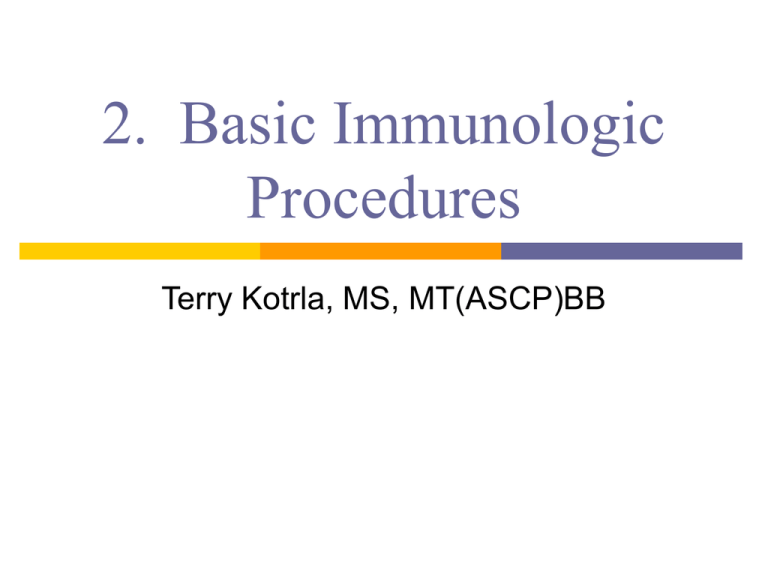2. Basic Immunologic Procedures Terry Kotrla, MS, MT(ASCP)BB
advertisement

2. Basic Immunologic Procedures Terry Kotrla, MS, MT(ASCP)BB Introduction Detection of antigen/antibody reactions difficult Can measure EITHER antigen or antibody. Sensitization is the binding of a specific antibody to its’ specific antigen Sensitization cannot be visualized Multitude of laboratory methods have been developed to make this reaction visible Factors Which Affect Reactions Concentrations of reactants Temperature Length of incubation pH of test system Three Distinct Phases of Antigen/Antibody Reactions Primary Phenomenon – Sensitization Secondary Phenomenon – Lattice formation Tertiary Phenomenon – Detected by affect on tissues or cells. Primary phenomenon Sensitization – binding of antibody to antigen – not visible Primary phenomenon Sensitization – binding of single antibody to single antigen site These tests are Difficult Complex Expensive Require special equipment Time consuming Primary Phenomenon Tests Techniques include: Immunofluorescence Radioimmunoassay Enzyme immunoassay Secondary Phenomenon Sensitization taken a step further to lattice formation Fab of Antibody molecule binds to two separate antigens on adjacent antigens If antigen on large structures such as RBCs causes agglutination. If both antibody and antigen are soluble results in precipitation Secondary Phenomenon Reactions Secondary Phenomenon These tests are: Easy to perform Less expensive Less time consuming Do not require special equipment Downside is Less sensitive Less specific More interference Secondary Phenomenon Examples of tests: Precipitation Agglutination Complement Fixation Tertiary Phenomenon Reaction not visible, detected by affect of reaction on tissues or cells. Tests include: Inflammation Phagocytosis Deposition of immune complexes Immune adherence Chemotaxis http://www.cellsalive.com/mac.htm Phagocytosis Secondary Phenomena Most Frequently Utilized Precipitation – soluble antibody reacts with soluble antigen Agglutination – particulate antigens bound together by antibody to form visible complex Complement Fixation – antibody binding to antigen triggers activation of complement, results in cell lysis Antigen-Antibody Binding Union of antigen and antibody requires Affinity Avidity Affinity and avidity determined by Law of Mass Action Antibody Affinity Describes the strength of a single Ag-Ab bond. As Ag and Ab come close together a chemical bond forms which is weak and can dissociate. How well the Ab fits the Ag will determine stability of bond, “lock and key” fit has strongest affinity. Ab may react with structurally similar Ags, results in cross reactivity. Most antibodies have a high affinity for their antigens. Affinity Avidity Describes the combined strength of multiple Ag-Ab bonds. Initially bond is easily broken, but multiple bindings at the same time the dissociation is overcome by the sheer number of bonds remaining. Avidity is influenced by both the valence of the antibody and the valence of the antigen. Avidity Affinity versus Affinity Affinity refers to the strength of binding between a single antigenic determinant and an individual antibody combining site whereas avidity refers to the overall strength of binding between multivalent antigens and antibodies. IgM and IgG Most frequently detected immunoglobulins. IgM has low affinity but high avidity due to 10 binding sites. IgG has 2 strong binding sites, high affinity and avidity. Law of Mass Action Governs the reversibility of the antigen-antibody reaction. Reversible reaction, visible reaction occurs when the rate of binding exceeds the rate of dissociation. As affinity and avidity increases, strengthens reaction. Precipitation Curve Depends on concentration of Ag and Ab. Prozone – antibody excess, many antibodies coat all antigen sites- results in false negative Postzone – antigen excess, antibody coats antigen but cannot get lattice formation, results in false negative Zone of Equivalence – antigen and antibody present in optimal proportions to bind and give visible reaction Precipitation Curve Precipitation Curve




